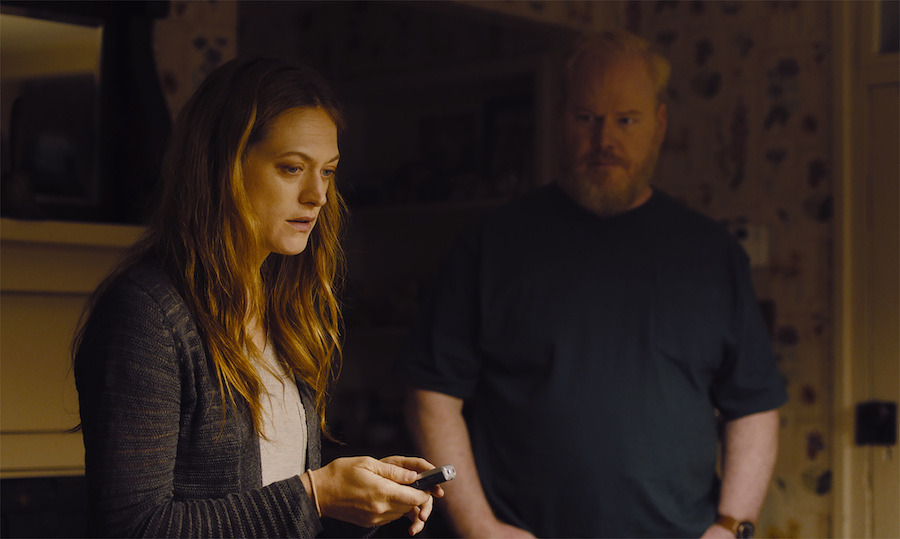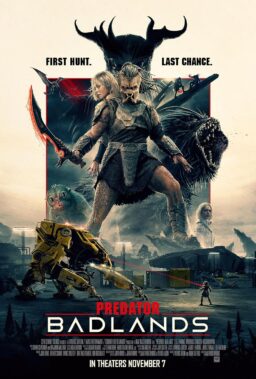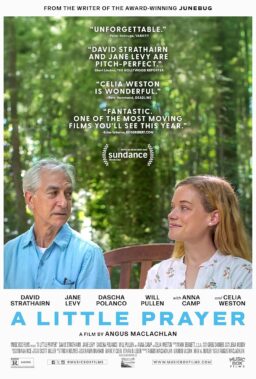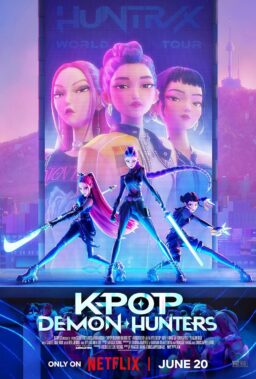“Light from Light,” Paul Harrill’s second feature film, premieres almost five years after his debut, “Something, Anything,” which I once praised on this site as a work of “theological humility and simple, unforgettable beauty.” I’m glad to report that both of these elements remain Harrill’s forte in the latest film, a story of a part-time paranormal investigator named Sheila (the fantastic Marin Ireland), who accepts an offer to help out Richard (Jim Gaffigan, in a stunning surprise turn), a man stricken by what seems terminal grief after losing his wife in an accident. I’ve seen “Light from Light” twice and I am continuously struck by how understated and strong it is. This is a supernatural story that, on paper, might suggest a melodramatic mash-up of “Ghostbusters” (1984) and “The Accidental Tourist” (1988)—and yet the film approaches all its essential themes (transcendence, loss, uplift) in a way completely at odds with a typical Hollywood product.
I spoke to Paul Harrill over Skype after just having watched “Light from Light” for the second time.
Your films seem quite simple, but the more I come back both to “Something, Anything” and to “Light from Light,” the more I am struck by how tightly structured they are. In a way, these are fast-paced movies, given how much happens to the characters and how many scenes you pack into the format of an 80-minute film. What is the writing process like in your case?
I spend a long time developing the story before I actually type something that looks like a screenplay. I try to understand as much as I can about the characters, and I use my notebook—both a paper and a computer one—to draft ideas for scenes. I usually end up with hundreds of them; some are just sketches, some are extensive. Then I order them into a rough chronology of how they would occur within the world of the film. Only after that I actually determine which of these I want to appear in the film. It’s really a matter of first understanding how emotional elements evolve and how plot elements follow each other—and then picking the ones that would possibly work on the screen and resonate against each other.
And once the scenes end up in the screenplay, how much of a fixed structure is it?
I keep rewriting and asking for feedback. As we cast the film, I invite the actors to talk about the script. Then, if something is not working, I rewrite again. Then, at the editing stage, stuff gets further cut out. In “Light from Light” I cut several characters from the film. Some of them were brief interactions, for example at Sheila’s car rental counter. But there was also one major sequence with several characters I eliminated. It was very plotty, but it didn’t advance the story enough. I also wrote a new scene once we were in post-production. So, it really is a process of constantly reviewing the material.
One of the most daring things about “Light from Light” is how it invokes horror genre elements only to play them in the most unassuming and gentle way imaginable. The scene of exploration of the haunted house comes to mind. Were you afraid that the film would somehow slip into the genre?
I very much wanted to avoid that. I don’t know if it was a fear (which is a funny word to use in this context). We weren’t afraid of the film having some suspense. When you are walking around a dark house with a flashlight, whether you believe in ghosts or not, it’s natural to feel some tension. When I shared a very early draft of the screenplay with my filmmaker friend who is much more interested in genre filmmaking, he got very angry. He felt like I was rejecting every opportunity to explore a horror scene when it presented itself. He found that maddening. I didn’t want to upset him, but this reaction actually made me very happy. It meant I was on the right track.

I cannot really think of many examples of American films seriously exploring the theme of a character possessing (or possibly possessing) some sort of a supernatural gift without reverting to sci-fi driven imagery of, say, “The Green Mile” (1999). In fact, apart from Ellen Burstyn’s turn in “Resurrection” (1981), no other film comes to my mind—until yours. How did you work with your wonderful lead actress, Marin Ireland, to create Sheila’s characterization?
I think both for Marin and me the way to approach the character was to be specific and very much ground things in the everyday. Even if you have, or have had, these kind of experiences, it’s possible, or even likely, that the overwhelming amount of your life is still very mundane. In the case of the character of Sheila, she isn’t even sure any more if she ever had that gift (or if she still has it). That doubt is something Marin and I talked about, and I think it helped in creating something that feels very real. Even if you have zero belief or interest in the supernatural, there’s still a way to connect with her character because of that self-doubt because we’ve all felt it somehow. For example, if you think of other elements of your life, like love—you may be in love, may be in a loving relationship, and yet if that relationship ends you may wonder: “I don’t know if I was ever in love to start with”. You can come to doubt something that felt true for you earlier. I think it’s common to do that, and that’s the kind of doubt Sheila feels.
As different as both of your features are, there is a sense of serenity about them that I find deeply appealing. The world of your films seems somehow immune to the madness of our time — be it political, social or technological. How do you create this sort of a safe space?
That’s something I want my films to do, or to be. But I can’t say exactly that I’m trying to engineer this experience for anyone. If this is created it has to do with the way I approach cinematography, which is very much about simplicity, and the rhythm of the editing, which is something I work very hard on. But on a deeper level, this will probably sound pretentious, but when you asked the question it made me think about something I read in an essay about the Dutch painter Vermeer. It was describing the darkness Vermeer saw in his time—religious wars, a massive gunpowder explosion that nearly leveled the city where he lived, and so on. And yet his paintings are so serene. The author’s argument was, you know, that he wasn’t documenting serenity—he was creating that serenity, perhaps as a response to his times, with his work. Or he was using his work to search for it. That’s stuck with me for a long time. The way you make it is to look for it.
Both your films are concerned with self-exploration, which strikes me as a deeply Emersonian notion. I was amused to learn that your film company has the name of Self-Reliant Film, an Emersonian name for a movie outfit if there ever was one. Did American Transcendentalism influence you in any way … ?
The name of the company was definitely a nod to Emerson and Thoreau. Those Transcendentalist ideals of non-conformity, and simplicity and the importance of nature are important to me. And as far as self-reliance goes … I live in East Tennessee—while it’s not just me making these movies, I have great collaborators—we’re a pretty scrappy group of people who get films made by shared effort.

You are a big proponent of regional filmmaking, as a director, scholar, programmer, etc. How would you describe the effect of making a film within a small community?
That’s a really important part of the film: writing the film with specific places in mind and then making it with and around the people whom I see every day. Not everyone I work with is from the community where I make my films. Many of the producers—James Johnston, Toby Halbrooks, and David Lowery from Sailor Bear, and Kelly Williams from Ten Acre Films, for example—they live in Texas and continue to make work there. Even though our places are different, there definitely is this sense of commonality, since they also have an attachment to a place. And making films in East Tennessee, the community support is tremendous. We aren’t a film crew landing in a town, setting up our trailers, using its resources and then leaving. We aren’t just there to put money in the economy through hotels or restaurants. We create something else. People are excited when we film here. The owners of the farm house in “Light from Light” were so excited for the film, they came to Sundance for the film’s premiere. They felt ownership in the movie, and that’s important.
It’s also how those films become documentaries of the places you film in.
It’s funny—when I look at “Something, Anything”, there is a big red staircase in the library scenes. It’s been repainted yellow since then and I can’t get used to the new color. But it’s there, preserved on film.
One of the film’s revelations is Jim Gaffigan’s performance as Richard.
This always surprises people, but I wrote the part with Jim in mind. I heard an interview he gave on NPR when I was first developing the script. In Richard, I wanted a character with real physical presence. Jim has that. And then, that interview I heard had depth to it that I didn’t necessarily associate with Jim’s comedy. I had seen him in one dramatic role and I thought he was quite good. I thought there was something to the concept of the audience approaching him with his comedic persona in mind, but then not finding it in my film. With Jim in the role, we can understand that Richard has had joy in his life.
That he’s capable of laughter.
That he’s capable of it—and that he has been drained of it. So, that’s where that came from. Elisabeth Moss got him to read the script. I had many long, deep conversations with Jim about the character. Among other things, he shared with me the experience of almost having lost his wife. He connected to the part very deeply.

Music and sound in the film are very interesting. You are doing a balancing act between long stretches of silence and music that is just this side of eerie, a bit like in “Carnival of Souls” (1962) gone realistic.
In “Something, Anything,” there already were really long stretches of silence. On “Light from Light,” I worked with Johnny Marshall, who is a wonderful sound designer and understood the film from the word go. With the composers, Adam [Granduciel] and Jon [Natchez], we talked about artists and albums like George Harrison’s All Things Must Pass, or Mark Hollis and the late Talk Talk records that play with significant silences.
Spiritual life in your films means work—it’s about a process of looking inside yourself and striving for a fuller life. Why do you think we usually have trouble discussing spirituality?
I think our obsession with work and multi-tasking make introspection and spiritual work very challenging. But, in terms of the difficulty in discussing it, I also think it’s fear of embarrassment. We live in times in which more of us are seeking than are willing to admit. We don’t want to talk about it. It’s scary to talk about it, because when we are seeking we don’t have answers, we don’t understand what’s happening in our lives. I tried to represent that process in my two movies. The meaningful moments that happen between people in the films occur when they allow themselves to be vulnerable and honest about their own experience, their questions, their searching. It’s very hard to do, but it’s something we should strive to do.












